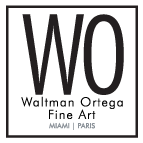Marcus Egli was born in Zurich in 1957 to a family of craftsmen and he studied precision engineering. He considered himself as much a metalworker as he did an artist. He spent part of his youth drifting happily and was offered a bursary at an art college to study arts. Before taking up his place at college, he travelled to America, and on his return to Switzerland, he decided to set up his studio. Marcus and his wife Rita bought an aluminum forge and workshop, where the Eglis began producing art work since around 1985.
Marcus Egli was one of Switzerland’s most successful sculptors with his distinctive work in aluminum. Starting with raw aluminum, he heated, hammered, cut, welded and polished each piece by hand, making each figure unique. Egli called his mini sculptures “Hominiums”. These sculpted figures, often generic, can be found in rows, lines, blocks, some are in cages, others scattered loosely, the artworks illustrates Marcus’ fascination with freedom and the issues of humanity. Egli’s faceless, aluminum crowds reflect the modern world, often literally, where people live trapped in the boxes of their homes, the restrictions of their jobs, and the constraints of societal pressures.
Marcus and Rita Egli lived and worked in a mountain village outside of Neuchâtel, Switzerland. Marcus Egli passed away from terminal illness in the summer of 2016. By the artist’s wish, the Marcus Egli Atelier spearheaded by Rita Egli continues his legacy by keeping “Hominiums” mini-sculptures alive and carries on their production using Egli’s processes and methodology.
Marcus Egli does not call himself a sculptor but a “metallier”, or metalman. He crafts aluminium in his workshop in Les Ponts-de-Martel, a small Swiss village in the Neuchâtel canton.
These works are often variations around the motif of the “Hominium”, a small figurine with a stiff posture. His polished face where the viewer discovers his reflection gives him his gaze. It plays on the contrast of materials, the raw and rough appearance of the body combined with the smooth.
Marcus Egli stages his “Hominium”, brings them together, conditions them. He creates loose or dense crowds, blocks, galleries of portraits. As he explains himself, “the crowd is often just a pretext. It can be little “we” that we put together, our anxieties, our hatreds, our loves, our vices… which then make a whole. Behind the crowd, it is always the individual that we find. Because all the characters are made one by one. They are practically alike, but never completely identical. It’s like us, we each have our own identity. It is these little identities that make the crowd ”.
Marcus Egli stages, even directs his “hominiums”, assembling them, conditioning them, forming sparse or dense crowds or blocks of them, and even portraits galleries.
